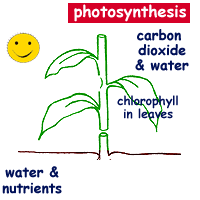|

Plant Parts - Leaves
Leaves are the food making factories of green plants. Leaves
come in many different shapes and sizes. Leaves can be simple.
They are made of a single leaf blade connected by a petiole
to the stem. An oak leaf or a maple leaf are examples. A
compound
leaf is a leaf made up of separate leaflets attached by
a petiole to the stem like an ash or a locust.
Leaves are made to catch light and have openings to allow
water and air to come and go. The outer surface of the leaf
has a waxy coating called a cuticle
which protects the leaf. Veins carry water and nutrients
within the leaf.
 Leaves are the site of the food making process called photosynthesis.
In this process, carbon dioxide and water in the presence
of chlorophyll (the green pigment) and light energy are
changed into glucose (a sugar). This energy rich sugar is
the source of food used by most plants.
Leaves are the site of the food making process called photosynthesis.
In this process, carbon dioxide and water in the presence
of chlorophyll (the green pigment) and light energy are
changed into glucose (a sugar). This energy rich sugar is
the source of food used by most plants.
Photosynthesis is unique to green plants! Photosynthesis
supplies food for the plant and oxygen for other forms of
life.
A green plant helped make the oxygen you are breathing
today.
 Go
on to the next plant part >>> Go
on to the next plant part >>>
|



